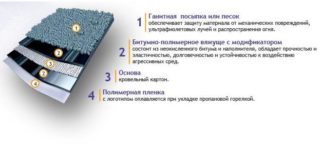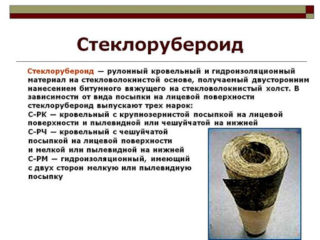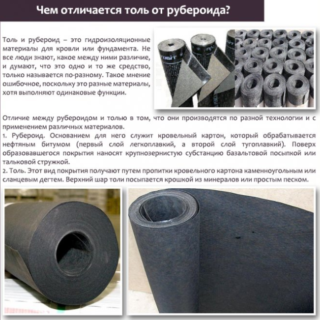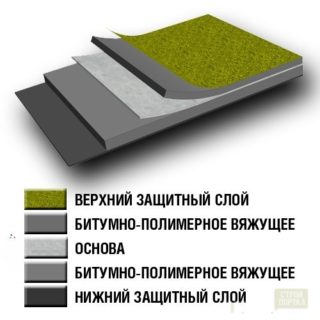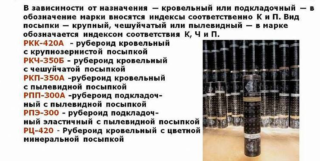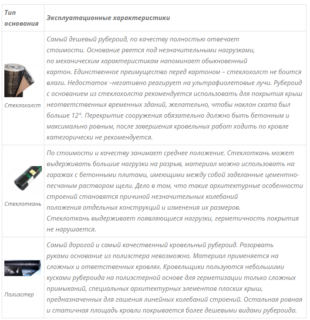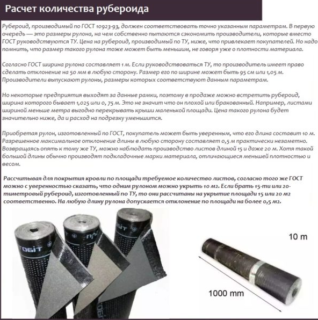Bitumen-impregnated cardboard is used as a roof covering of a house, it is also laid as a waterproofing when constructing a carpet made of other materials. Modern roofing felt for the roof is produced using new technologies, as a result of which it acquires improved performance characteristics. The cellulose base is replaced with fiberglass, therefore, the tensile strength of the material increases.
Varieties of roofing material for the roof and characteristics
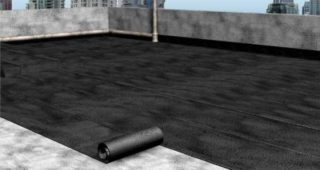
Spreading is performed on the surface of the material from below and from above, and a modified film coating is also placed. This protects the layers from sticking together during transportation and storage, increases resistance to negative atmospheric factors.
Types of roofing material:
- rubemast;
- glass roofing material;
- roofing paper;
- euroruberoid.
For the lower layers of the coating, a standard RCP roofing material with a mass of 800 g / m² is placed on the crate. The design breaking load is 26 kgf, the material is covered with talcum on top and bottom. For laying the first layer, RPP roofing material (lining) is also used, 1 m² of which weighs 500 g, and the breaking force is standardized at 22 kgf. The rolled carpet is covered with dusty talcum powder on both sides.
The upper roofing flooring can be laid with a soft layer of RKK roofing material, it is also used for intermediate laying. The square of the layer weighs 800 g, the calculated tensile strength is 32 kgf. Roofing felt heat resistance up to a heating temperature of + 80 ° C for two hours, has a coating in the form of talcum powder, mineral chips are added on the upper side.
For production, they take petroleum construction bitumen according to GOST 6617 - 1976, amended in 1994 and GOST 22.245 - 1990, supplemented in 1997. They take grades of bitumen BNK 90/10, 90/40, 90/30, 45/80, 60/9040 / 80. Roofing cardboard is standardized in accordance with GOST 31.35 - 1982, fiberglass - NPG 210 and T-13. Coarse-grained crumb, sand and building lime are used for sprinkling.
Rubemast
The biodegradable flooring can be laid on solid battens without first applying heated resin and using mastics. The thick bottom layer is heated with a burner and pressed against the base, this technology increases labor productivity. Rubemast has an acceptable cost.
Standard Features:
- tensile force - not less than 294 N;
- square weight - 3 - 4 kg;
- heat resistance - up to + 80 ° С;
- roll width 1 m, length 10 m;
- top dressing - talcum powder or mineral granules;
- lower protection - talc.
From the side to be welded, the weight of the binder is not less than 1.5 kg / m², water absorption should not exceed 1.5% of the weight during the day. The material retains its resistance to cracking when the temperature drops to -15 ° C.
Repair of the rubemast coating is done by applying two-layer patches; complete dismantling is needed only for major repairs.
Glass roofing material
Having studied the brands, you can determine which roofing material is better for the roof:
- type S-RK - the material to cover the roof is produced with large granules on the front side and dusty talcum powder or a layer of fine-grained fraction from below;
- S-RF - used for the top layer, produced with scaly face protection and fine-grained at the bottom of the roll;
- С-RM - put as a waterproofing coating, dusting or fine fraction on both sides.
The roll has a width of 0.96 and 1.0 m, the thickness of the glass roofing material varies within 2.5 mm, a run of 0.5 mm in the direction of increasing or decreasing is allowed. Softening occurs after heating to + 85 ° C, and the material becomes brittle after cooling to -15 ° C. During tests, moisture saturation is allowed not more than 25 g / m2, and the strength should be not less than 30 kgf. The roll weighs an average of 23 kg.
For brands that are intended to cover the top layer, a non-sprinkled edge is provided from the top side to a width of 7 - 10 cm for ease of installation. The cost is significantly higher than that of a standard cardboard-based roofing material, but the service life is much longer.
Tol
Technical characteristics of different brands of roofing roofing:
- TK 350 - for vapor barrier and top layer, weighs 350 g / m²;
- TG 350 - moisture insulation, weight 350 g / m²;
- TP 350 - covering layer or insulation during the installation of corrugated board, slate, weighs 350g / m², covered on both sides with additional surface impregnation and quartz dressing;
- TVK 420 - the upper deck of temporary structures or the first layer in the roof covering made of other materials, weighs 420 g / m², impregnated with refractory tar on both sides.
The quality of the impregnated cardboard must comply with GOST 10.99 - 1976 “Technical requirements. Roofing felt ".
Of the positive aspects of the application, the low cost of the material is noted, while it is always on sale. Cheapness attracts developers if they are doing temporary work.
Euroruberoid
Characteristics of euroruberoid:
- weight not exceeding 1.7 kg / m²;
- water absorption is not more than 24% by weight;
- boundary temperature of hardness - + 80 ° С;
- sprinkling on the top and bottom of coarse sand or mineral chips;
- roll width 1 m, length 15 m.
Fiberglass is an accumulation of fiberglass, and a press is used to secure them. This technology reduces the cost of euroruberoid without reducing the quality. A frame fabric made of glass fibers increases strength, which is important if you cover the junction points in valleys, gutters and in the area of \ u200b \ u200bthe ridge, to attach roofing material to a wooden roof. Polyester is formed by melting polyethylene. The inner base increases the resistance of the euroruberoid to abrasion, rays, organic harmful components. Euroruberoid is distinguished by the type of base, the presence and type of sprinkling, the weight of the square.
Marking and thickness of roofing material
Government labeling:
- the first letter P means that the material is classified as roofing material;
- the second letter K or P refers the material to a lining or roofing group;
- the third indicates the size of the covering dressing: M - fine-grained, K - coarse fraction, P - dusty, E - elastic, C - stable color;
- the figure indicates the weight of one square of the material.
Thick material weighs more, loads the crate, rafters. The use of a specific type of roofing material is determined by calculation so that the roof structure does not experience unnecessary efforts.
Advantages and disadvantages
Roofing material as a building material has pros and cons of use. Often its choice for roofing is determined by its low cost.
Material advantages:
- Modern types are easily applied with a burner to various coatings, you can cover a concrete or metal base, lay roofing material on a wooden roof.
- The work is carried out in a short period of time, the layers quickly stick and harden.
- The material is distinguished by increased strength, increased calculated tensile forces, resistance to high temperature in comparison with glassine, which has no dressing.
- Can be applied to complex roof shapes and applied on different slopes.
The disadvantages include the easy flammability of the coating and low rigidity compared to solid roofing, piece natural tiles. Roofing material, produced according to old technologies, becomes brittle in frost and softens when heated in the sun. Such types cannot be laid with a burner; they require preliminary coating of the base with molten resin or mastics.
Application area
A durable glass roofing material is used in the bottom and top coat. Grades S-RK, SR-Ch with coarse-grained and scaly protection are set for the top, and the C-RM category with a dusty and fine-grained layer is used as the first layers in the roofing cake.
Roofing paper of the TK350 group without dusting is used as a vapor barrier layer in the construction of roofing. Roofing brand TN350 without a top layer is placed to protect against moisture. Category TP350 with sand grain protection and double-sided film protection is used for temporary roofing or initial layer in roofing. Roofing paper TVK 420 with coarse fraction sprinkling and impregnation with tar is used similarly to TP350.
Euroruberoid is more often used for its intended purpose - as a roofing top coating.
DIY installation features
Work order:
- preparation of the area, cleaning, priming with primer;
- rolling and trying on material on the surface;
- fusion of the backing layer;
- installation of the upper layer;
- checking the tightness of the joints.
The material is fused with propane burners, the flame strength is adjusted so as not to burn through the roll. The upper and lower layers are placed using a similar technology. The material is laid with an overlap, the correct width of which is equal to the distance of the edge to the side of the roll.If there is no such strip, the junction is cleaned of the top dressing and warmed up.
If the seam visually looks leaking, it is better to walk over it with a torch and press it again.
Maintenance and repair work
Correction of leaks is organized immediately after the detection of a weak point so that the coating does not deteriorate further. Patch repair of problem areas is done in 2 layers at least. The exfoliated mass is cut out at the site, and the base of the roof is cleaned, primed, and allowed to dry (3-4 hours).
If, as a result of the inspection, it is revealed that it is possible not to cut out all the layers, the upper layer is cut with a cross and the edges are raised. The sprinkling of the inner coating can interfere with the adhesion of the patch, so it is cleaned off and the surface is primed.
On the roof, multiple small defects are often found with the integrity of the overall coating. In this case, it is recommended to weld a large piece of roll onto an old surface. It is cleaned of crumbs, lubricated with ready-made mastic or molten resin to increase adhesion. Then the roll is glued by heating with a burner. Regular inspections help to maintain the integrity of the coating and to get by with little money for repairs.

